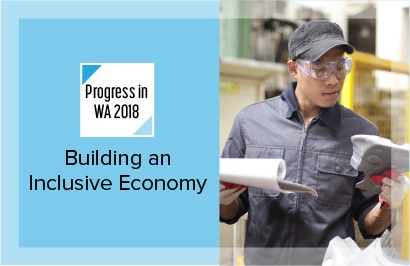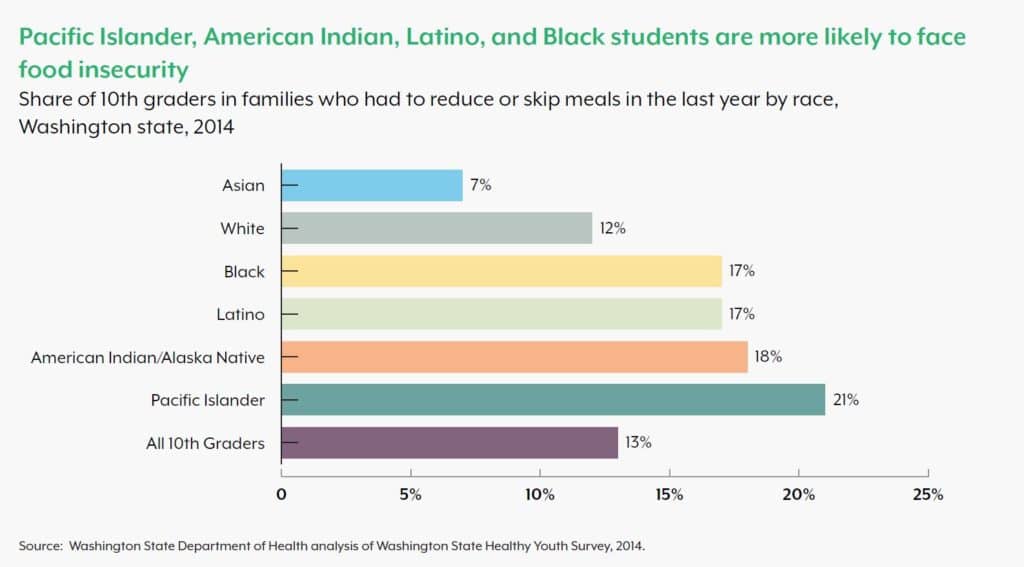Washington is poised for great economic progress. By many measures, a better future for all people in our state is within our grasp. And yet, economic growth is not reaching all Washingtonians. There are persistent and deep disparities based on race, ethnicity, nativity, class, and geography across every measure of economic progress. Progress is meaningful only if it’s felt by everyone and prosperity is shared by all Washingtonians. To create real progress, our state must have an inclusive economy in which everyone, especially people with low incomes and people of color, can participate in growth and benefit from it. Those are the primary findings of our “Building an Inclusive Economy” report (the first in our Progress in Washington 2018 series of reports).

Washington state’s own upside-down tax code has contributed to the problem. Hardworking families in our state pay as much as seven times more than the wealthiest pay while corporations and the ultra-wealthy benefit from unnecessary tax breaks, making it hard for our state to have the revenue it needs to invest in the foundations that serve us all, such as great schools, quality health care, and other public priorities that make Washington a great place to live. Policymakers must fix our broken tax code. Doing so will allow our state budget to have sustainable sources of revenue to build an inclusive economy and to invest equitably in our communities in the short and long term.
Prosperity should be within reach of all Washingtonians
Making sure all Washingtonians have access to opportunity and resources is essential to ensuring prosperity is within reach of all residents. Across many indicators of economic progress, the data show that people with low incomes and people of color are starting off on unequal footing and are facing greater barriers in large part because of the impact of harmful historical housing, economic development, and financial policies. As Washington grows more racially and ethnically diverse, the future well-being of all of us hinges upon erasing the deep and pervasive racial imbalances that exist across these measures. By 2050, our state population will be majority people of color. Washington state’s young people are already at the forefront of this demographic transformation. Forty-three percent of children are kids of color.
Click on graphic to enlarge.
In an inclusive economy, all Washingtonians – regardless of race, ethnicity, nativity, income, or community of residence – would be able to access quality jobs and have financial security and stability. Our education system would be preparing students and workers for good jobs and jobs of the future. And all Washingtonians would be able to live healthy lives in vibrant communities so they can better connect to and participate in the economy. However, data trends highlighted in our report indicate economic prosperity is out or reach for many residents in three key areas – economic security; education and job readiness; and healthy people and communities. For example:
- Economic security: Although economic growth holds the promise of prosperity for working people across the state, rising employment has not reached all communities. While unemployment in Washington state has overall dipped to 4.5 percent, for many communities of color – such as Pacific Islanders, American Indians, and Blacks – unemployment rates remain at or near 10 percent. There are geographic differences as well: the unemployment rate has remained high in many rural counties. In Ferry County, the unemployment rate is the highest in the state at 9.1 percent, and in Pacific and Wahkiakum counties, unemployment remains at just above 6 percent.
- Education and job readiness: While the state’s Department of Early Learning’s goal is for 90 percent of kids to start kindergarten with the skills they need to succeed, currently only 47 percent of kindergartners are meeting that threshold, and there are significant differences by income and race. Only 33 percent of kids with low incomes, 27 percent of Pacific Islander kids, 30 percent of Latino kids, and 32 percent of American Indian kids were kindergarten ready in 2016.
- Healthy people and communities: In Washington state, many low-income communities, communities of color, and rural communities experience worse health outcomes when it comes to chronic diseases, life expectancy, obesity, and more. Thirteen percent of households in Washington struggle with food insecurity – the inability to have three meals on the table every day as a result of lack of resources. Among 10th graders, Pacific Islander, Latino, and Black students have the highest likelihood of living in families that had to reduce meal sizes or skip meals compared to overall state average.
Click on graphic to enlarge.
Note about data: Disaggregated data is presented to provide a preliminary understanding of disparities by race, ethnicity, and nativity. On its own, the data throughout the report tells a limited story about the population it represents. We encourage users of this data to engage with communities of color to develop a more accurate and meaningful understanding than the data allows.
These and other trends highlighted in the report point to the fact that much work remains to be done for policymakers and all of us to advance shared prosperity and progress for generations to come. Our state budget and tax code are powerful tools to make this happen and to build an inclusive economy. In the upcoming 2018 legislative session and beyond, policymakers can choose to advance shared prosperity by making sure our state budget and policies increase economic security, promote racial equity, ensure all kids have access to great schools, and build thriving communities for everyone.
Stay tuned for the next publications in the Progress in Washington series, which will explore policy solutions that address the barriers to opportunities described in the “Building an Inclusive Economy” report.
“Building an Inclusive Economy” is the first report in our Progress in Washington 2018 series. The report is intended to offer a framework for understanding the challenges before us. To reach the goal of an inclusive Washington state economy with shared prosperity for everyone, we need to know where we are, where we need to be, and how we can get there.

